5g millimeter wave technology
5G millimeter wave technology represents a groundbreaking advancement in wireless communications, operating at frequencies between 24 GHz and 100 GHz. This revolutionary technology enables unprecedented data transmission speeds, making it a cornerstone of next-generation mobile networks. The technology utilizes shorter wavelengths than traditional cellular frequencies, allowing for significantly higher bandwidth and reduced latency. By leveraging multiple-input multiple-output (MIMO) antenna systems, 5G millimeter wave can support thousands of simultaneous connections while maintaining exceptional performance. The technology's high-frequency waves excel in dense urban environments, providing multi-gigabit speeds ideal for data-intensive applications. Despite its limited range compared to lower frequencies, strategic placement of small cells and beamforming technology effectively overcome these limitations. The technology finds applications across various sectors, including autonomous vehicles, smart cities, industrial automation, and augmented reality experiences. Its ability to handle massive amounts of data makes it particularly valuable for Internet of Things (IoT) deployments and mission-critical communications. The implementation of 5G millimeter wave technology has already begun transforming how we connect and communicate, setting new standards for wireless performance and reliability.


